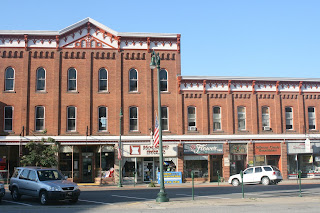View Delaware Canal State Park, Sommer's Bridge in a larger map
Visit our Tour Destination:
 |
| The restored Sommer's Bridge in Delaware Canal State Park. Photo courtesy of Delaware Canal State Park. |
Sommer’s Bridge
The park is located along the historic canal and towpath
paralleling the Delaware River on the Pennsylvania side
from Easton to Bristol .
Sommer’s Bridge spans the canal
in Lower
Makefield Township
approximately a half mile south of I-95.
Website: Delaware Canal State Park
The Treasure: The
Delaware Canal
Background: Two
years after New York ’s Erie
Canal opened to lots of fanfare in 1825, the Pennsylvania State
Senate passed a bill to dig a canal of its own. There were solid economic
reasons for states to invest in canals. As the most cost-efficient commercial transportation
systems then available, canals were good for business. Large deposits of
anthracite coal had been discovered in northeastern Pennsylvania
and there were huge markets for the coal in cities like Newark ,
New York City, and Philadelphia . To get the coal to Newark and New York City , New Jersey dug the Morris Canal Pennsylvania , the Delaware
Canal was constructed to transport the
coal to the state’s largest city, mutually benefitting the economies of
northeastern Pennsylvania and the growing
industries of Philadelphia .
 |
| View from Sommer's Bridge. Photo courtesy of Delaware Canal State Park. |
The digging commenced in October 1827. Nearly five years
later, the 60-mile-long canal celebrated the delivery of its first shipment of
coal, with a loaded barge traversing the distance from Easton
to Bristol .
During its first forty years, the Delaware
Canal more than justified its $1.43
million expense, fueling the growth of industry in eastern Pennsylvania . The engineering required was
impressive: the canal utilized 23 lift
locks to control water flow, along with an array of aqueducts, waste gates,
dams, and overflows. But in practice, it didn’t look particularly
sophisticated. Slow but steady, teams of mules trudged along the towpath,
pulling barges loaded with up to 90 tons of coal.
The heyday of the American canals lasted only a few decades. As
new railroad lines were built in the middle of the 19th century, the
important role of the Delaware
Canal
 |
| Sign posted during the restoration. Photo courtesy of Delaware Canal State Park. |
Save America’s
Treasures funding was used to preserve one of the original bridges built to
span the canal. Dating back to 1831, Sommer’s Bridge
is located just 15 miles from the terminus of the canal at Bristol ,
close to Philadelphia .
In the early days, over one hundred small camelback bridges of this type
crossed the canal. Today, only six remain. Thanks to the Save America’s Treasures funding, Sommer’s Bridge was the fourth of
these surviving historic bridges to be restored.
The best way to
see Sommer’s Bridge is to hike the towpath, a National Recreation Trail.
 |
| Sommer's Bridge during restoration. Photo courtesy of Delaware Canal State Park. |
 |
| Sommer's Bridge, restored. Photo courtesy of Delaware Canal State Park. |
Other Recommended
Sites: A hike along the towpath takes you past one historic site after another,
with opportunities for stopovers at several delightful small towns. For iconic national history, Washington Crossing Historic Park is located just three
miles north of Sommer’s Bridge. Small towns like Yardley, New
Hope , Lumberville, Erwinna, and Upper Black Eddy cater to tourist
crowds who come to Bucks
County
 |
| Delaware Canal State Park. Photo by Bradford Van Arnum. Source: Wikimedia Commons. |
Tour America's History Itinerary
Wednesday: Atmosphere and Environment XII by Louise Nevelson
© 2013 Lee Price











